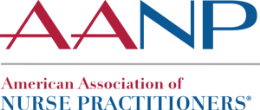AANP Member Spotlight: Bringing the Nurse Practitioner Point of View to Big Tech

Hear from AANP member Kristi Henderson, DNP, FNP, ACNP, FAEN, on her experience working at the intersection of health care and technology.
“As I began working in emergency medicine as a nurse, I became aware of a severe supply and demand issue in health care,” says Dr. Kristi Henderson. “I knew that our physician colleagues were challenged with the volume of patients, and I wanted to contribute and help address the challenges of access to quality care.”
She returned to complete her family nurse practitioner (FNP) program and developed an interest in how NPs could help alleviate this burden—particularly in the area of telehealth.
“In my next role with Ascension Health, I led the virtual care program for the Texas market and ultimately for their corporate office for the entire U.S. market—but it was more than just virtual care. It was about increasing access through new models of care, enabled by technology, to build highly effective and sustainable solutions that had measurable value,” she explains.
Telehealth—Evolution and the Future
Dr. Henderson’s initial foray into telehealth was the development of a statewide telehealth model in Mississippi that came to be recognized as a Center of Excellence by the Health Resources and Services Administration. She also served as an executive board member for the American Telemedicine Association.
“When we look at how telehealth has changed, it’s truly phenomenal,” she says. “When we first implemented the program, the medical and nursing boards were highly skeptical. We conducted three hospital pilots, with quarterly reviews, for seven or eight years. There was no cloud or broadband infrastructure. It was all point-to-point connections between distant sites—and it worked! It was about bringing wider access to care using the resources available to us.”
She notes that there remains a need to this day to modernize policies and regulations in order to unleash the full potential of telehealth, including what can safely be done to take advantage of our connected health ecosystem.
“We now know the telehealth model is effective, and we need to ensure the existing language is updated at the local, system, state and federal levels in order to refrain from inadvertently limiting its capabilities,” she says.
The Partnership Between Tech and Health Care
According to LinkedIn, large technology companies like Amazon, Apple, Microsoft and Alphabet (Google’s parent company) have made the move to hire more individuals with health care skills. In fact, Dr. Henderson herself is an example: She transitioned to a role with Amazon earlier this year.
“We need to meet the health care needs of our country in a sustainable way, but it’s a dynamic problem, as demand continues to increase and change,” Dr. Henderson says, noting how many health care systems are working on innovations to address this very issue. “I’ve seen the impact of new solutions—such as telehealth and a more diverse workforce—and how technology can be used to improve health outcomes.”
Health care and tech can combine to be a powerful force for change, and health care professionals like NPs are more frequently invited to the table to collaborate on nontraditional solutions. Whereas tech companies traditionally launch a product and then evaluate how consumers respond, health partners can merge a rigorous attention to quality and safety with a desire for advancement, like consumer-facing solutions, price transparency and a frictionless network.
“Patients and all consumers expect quality, safe and convenient care. They shouldn’t walk away feeling worse or frustrated that they could not get service when they needed it,” Dr. Henderson says.
“There’s been a lot of discussion about getting NP voices to the table. Our voices are needed because we bring an important perspective. When we consider employers outside traditional work environments and are a part of the redesign of health care delivery, we can encourage an environment of innovation without sacrificing quality and safety.”

Learn How to Become an Effective Health Care Leader at the 2019 AANP Fall Conference
Are you interested in discovering how NPs can contribute to the future of health care? You won’t want to miss the 2019 AANP Fall Conference!
With four topical areas—including Leadership, Workshops, Pharmacology and Cardiometabolic—and the bright lights of the Las Vegas Strip as your background, it’s an exciting opportunity to develop your skills, share information and meet new colleagues.
A number of additional sessions are available for new and emerging leaders, including:
- Leaders as Change Agents: How Do You Wear Change?
- Communication Skills & Strategies
- Creating a Culture of Safety & Quality
- Ethics for Leaders in Healthcare
Add one—or more—to your schedule to expand your knowledge or attend them all to become a true leader of tomorrow. In addition, through a collaboration with George Washington University (GWU), attendees have the opportunity to register for 12 bundled sessions to earn an “AANP Introductory Certificate in Leadership.” As you are selecting your sessions, simply choose the first presentation, F19.1.007 Leaders as Change Agents: How Do You Wear Change? (Certificate), and you will be automatically registered for all 12 GWU sessions!

